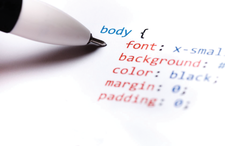Making the most out of Cascading Style Sheets
Command Line – CSS

© Lead Image © photovibes, 123RF.com
Cascading Style Sheets can provide a sophisticated layout for articles and books. Here are a few tips to get you started.
If you have created HTML or JavaScript in the last two decades, you probably have a nodding familiarity with Cascading Style Sheets (CSS) [1]. Not only is the CSS stylesheet language commonplace on the Internet, but popular ebook formats like EPUB and MOBI use it as well. Moreover, because CSS is human-readable, if you know English, you can understand much of what is being done without learning the details. However, a formal look at CSS is likely to reveal missed details, not least of which is the number of options it provides.
CSS keeps format and content separate. Initially, markup languages like HTML were designed to do the same, but the distinction became blurred (if you are old enough, you may remember the infamous HTML blink tab). CSS was intended to restore the distinction by being a stylesheet that gave designers control over how pages are viewed. CSS has been only partly successful, because different web browsers continue to display some elements differently and to allow readers to override CSS with their own preferences. All the same, CSS remains popular, if only because most designers prefer to have some formatting control.
At any rate, CSS continues to be a standard feature of modern computing. Its specifications are developed and maintained by the World Wide Web Consortium (W3C), which also provides a CSS validation service [2]. However, be aware that different CSS uses, such as ebook publication on Amazon or Lulu, often have their own, sometimes arbitrary, standards for CSS stylesheets. A given stylesheet can be valid by W3C standards yet still fail to be accepted by a given publisher. It's time, though, for a closer look at CSS constructions.
[...]
Buy this article as PDF
(incl. VAT)
Buy Linux Magazine
Subscribe to our Linux Newsletters
Find Linux and Open Source Jobs
Subscribe to our ADMIN Newsletters
Support Our Work
Linux Magazine content is made possible with support from readers like you. Please consider contributing when you’ve found an article to be beneficial.

News
-
Zorin OS 18 Hits over a Million Downloads
If you doubt Linux isn't gaining popularity, you only have to look at Zorin OS's download numbers.
-
TUXEDO Computers Scraps Snapdragon X1E-Based Laptop
Due to issues with a Snapdragon CPU, TUXEDO Computers has cancelled its plans to release a laptop based on this elite hardware.
-
Debian Unleashes Debian Libre Live
Debian Libre Live keeps your machine free of proprietary software.
-
Valve Announces Pending Release of Steam Machine
Shout it to the heavens: Steam Machine, powered by Linux, is set to arrive in 2026.
-
Happy Birthday, ADMIN Magazine!
ADMIN is celebrating its 15th anniversary with issue #90.
-
Another Linux Malware Discovered
Russian hackers use Hyper-V to hide malware within Linux virtual machines.
-
TUXEDO Computers Announces a New InfinityBook
TUXEDO Computers is at it again with a new InfinityBook that will meet your professional and gaming needs.
-
SUSE Dives into the Agentic AI Pool
SUSE becomes the first open source company to adopt agentic AI with SUSE Enterprise Linux 16.
-
Linux Now Runs Most Windows Games
The latest data shows that nearly 90 percent of Windows games can be played on Linux.
-
Fedora 43 Has Finally Landed
The Fedora Linux developers have announced their latest release, Fedora 43.

